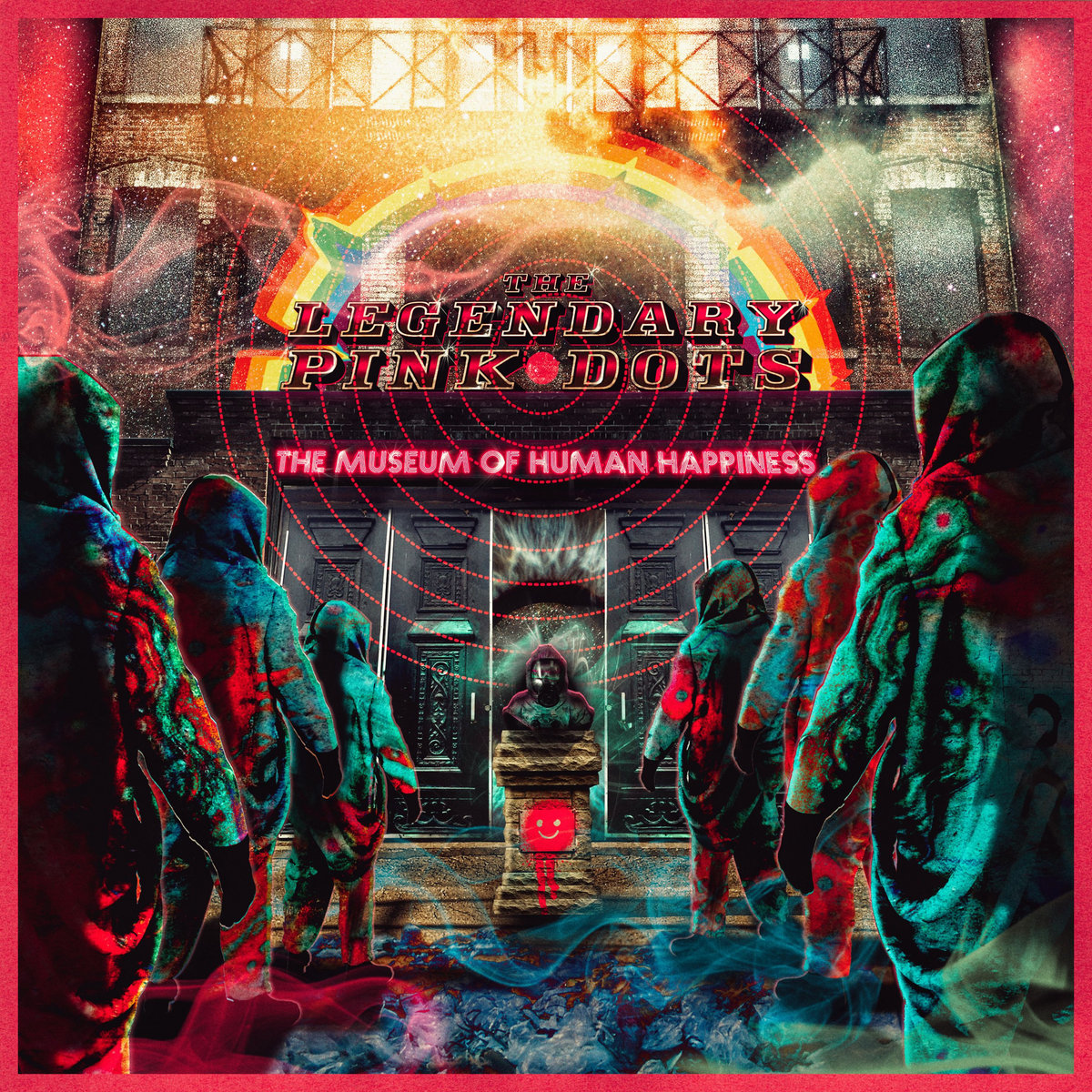THE LEGENDARY PINK DOTS – THE MUSEUM OF HUMAN HAPPINESS
Carlos Flaqué Monllonch- 08/26/2022

English:
Probably, there are bands that people have never heard of or that seem to inexplicably inhabit that semi-darkness that is so difficult to penetrate. They occupy those spaces where there is a dissimilar light, where shadows speak for themselves, and fears surface that can drive any human soul crazy. They are musical formations that seek to distance themselves from commerciality, from that sound that overwhelms us, that always sounds with the same patronage and that the masses consume immediately, but the next day it is relegated to oblivion. They are bands that do not transmit messages or thoughts. Transgression and genius are absent.
Trying to present The Legendary Pink Dots (LPD, from now on) is not an easy task since it is one of those formations that wanders beyond the normal, the mundane. As a result, every time I sit down to write about their work, it’s like trying to navigate a Sargasso Sea and trying to stick my head out in search of a few bubbles of oxygen. Sitting down to listen to LPD is like falling into the tangles of an extensive meander of deep Borgesian curvatures. It is simply trying to understand a puzzle of impossible coordinates, where mathematics and quantum physics try to make sense of a tremendous unintelligible human chaos.
The very name of the band produces confusion or chills, especially for those who could be classified as neophytes in their sound, but also for veterans who have been listening to their works for some time, either as a band in progress ( LPD ), or in their works. solo ( Edward Ka-Spel) and in parallel ( The Tear Garden) , respectively.
Talking about The Museum Of Human Happiness, the band’s first new work in almost three years, is like trying to condense the Cosmos inside a tiny box, that is, an impossibility that would lead us to develop an intangible space within an eternity. absolute. But aside from this metaphorical clarification, I would dare to say that this is one of the best LPD albums . Its concept, structure, composition and details are immense.
Hence, the majority of more specialized critics praise it as one of the most golden works of the band. For example, Narc from the UK: “Infused with emotional prowess, this album draws on the Dots’ strongest assets to create a release that is driven, focused and soulful . “ Or Sonic Seducer from Germany: “Happiness is still a matter of opinion, but The Museum Of Human Happiness is indisputably among the best Legendary Pink Dots albums” .
It should be said that The Legendary Pink Dots is an Anglo-Dutch experimental rock band formed in London in August 1980, and that operates outside the currents of the market since their music is incompatible with the brain mass of the mainstream . However, the band has managed to build and maintain a fierce and loyal cult following around the world, maintaining a long career of over forty studio albums, as well as a host of additional recordings. They have a long line of followers completely devoted to their creations. It is music to imagine, feel and think and, above all, to get carried away by its multiple hyperdimensional nuances.
Edward Ka-Spel (founder, vocals, keyboards), Phil Knight , also known as The Silverman (co-founder, keyboards, electronics), and guitarist Erik Drost , are responsible for this wonderful The Museum Of Human Happiness, a work that reaches nirvana at all levels. We are facing a work of creative luxury, of chilling sensitivity, that arises from a world shattered and sealed by the problems and poisons that suffocate its existence. It is an album, therefore, that emerges with its own identity, with a caustically ingenious and cryptically evocative style, which outlines a deviation from that dark psychedelic path that the band had taken on previous albums. This new state of mind, poetic and refined sound, unfolds like a precise high-end clockwork mechanism.
From the beginning, the album, released by Metropolis Records, plunges you into a dizzying whirlwind of daydreams, fast-paced percussion and a sinister mix of dreams, nightmares, claustrophobia and inexplicable dimensions. Basically, it is a work that reflects the tortuous human nature on what it produces or generates as a consequence: disorder and silence covered with an artificial beauty that forges disturbing and false happiness. And more so considering that due to the pandemic the composition and recording of this album took place in cyberspace during 2020 and 2021.
Edward Ka-Spel himself in the interview that Klemen Breznikar did for It’s Psychedelic Baby! Magazine, reminds us that “The pandemic reared its ugly head as we traversed Europe and then the world stopped. It was the last time The Legendary Pink Dots were in the same room together. From that moment, The Museum of Human Happiness had a lot to do with those circumstances (…) In the darkest moments we feel a bit like the four horsemen of the Apocalypse, spreading discomfort when life stops».
Without a doubt, The Museum Of Human Happiness is not a simple album of strange songs or for elitist minorities. Rather it is a complete experience, a set of sinister and brilliant fragments that reflect and distort the reality we live in, as well as the strange nature of our existence and our relationships throughout it.
This is also how Stephen Kennedy of the music portal Reflections of Darkness understands it when he writes that « The Museum of Human Happiness is a document of our resilience, stupidity and fear, and it seems to be on a higher shelf, looking down without judgment, just checking in and shaking his head sad and wise, seeing what we need, hoping we can get there.”
The lyrics on the album are heartbreaking. They describe narratives of solitary confinement and pessimism as suffering infiltrates through long, winding openings. It is a mind-blowing journey through existential and social metabolism. In this regard Ka-Spel says: “The lyrics are absolutely moving, desperate, sometimes with a flash of black humor, but ultimately they are a burning purgative fire .”
The album debuts the tracklist with This Is The Museum , a song that rhythmically takes us into that chilling museum where human happiness queues to be valued in the face of true happiness: «Here, in the sacred space, I promise you will cry (…) Along with those smiling faces (…) under the painted sky. This is the museum.” The album cover is decisive.
The second theme is There Be Monsters , which by its title flagellates the membranes, either because of its sound details, because of its undulating melody or because of its withering lyrics: «I see monsters, they come closer, but they don’t make a sound. They clean the head (…) until it bursts ». A clear message to politicians who destroy critical thinking in order to maintain the link between power and submission.
Cloudsurfer is insane, pure immersion into the depths of the downcast being surfing through the clouds trying to avoid the dark reality that lies beneath his feet. It’s six minutes of real nightmare. Drost’s guitar strumming is tremendous, hard and cutting like a knife, between piano hits and obsessively pernicious rhythms. A psychological slap in the face. For her part, Cruel Brittania dictates the follies of our time with aged wisdom and wit, taking aim resolutely at the stupidity of the political elite. Ka-Spel unravels in it that dangerous rise of far-right populism.
Nightingale is one of my favorite songs, a luxury of voices, sonorities and rhythms that dream and overwhelm like the tireless song of the nightingale bird that endlessly modulates all night long in search of perfect harmony. It is a masterpiece and very subtle, with registers and layers, a nightmare that engulfs you and leads you towards the last blinding light.
Hands Face Space is sharply paranoid, a melody composed under different rhythmic and dissonant layers, with ascents and descents, fusing sonic breaks, histrionic laughter and flashes of warning in the background. A complete delusion.
Coronation Street , has an electronic scale jolt that overrides your calm and plunges you into its thorny whirlwind. The percussion is vital and there is a certain King Crimson touch .
Postcards From Home is another of my favorite themes, a wonderful theme. Right from the start, it catches you in its tentacles. It manifests so softly that it hardly seems to exist. Everything slides slowly like an arachnid through its web. It exudes a biomechanical environment, under the trippy and wah-wah guitar effects . In short, a psycho-melodic journey that dissolves the neurons under immense oceans of imagination. The solo voice takes on immeasurable whispers.
The Girl Who Got There First and A Stretch Beyond constitute a sonic polarization since the contrast between the two is far from compositional. While the first track coils up the throat like poison ivy, it’s a clearly agonizing and desperate development with marked rises and falls. The second piece, however, is shown in a lower tone, almost slipping between calm and mystery.
Tripping On My Nightmares continues to meander through a sleepy landscape, suggesting that life itself is the only drug needed to look at the absurdity of human existence. The voice unleashes unusual registers, even bordering on the most experimental Bowie and a very twelve-tone Ka-Spel . The atmosphere takes unimaginable heights and tortuous digestion. Nirvana For Zeroes , with an oriental start and an air of psychedelic bands from the 70s like Gong or Amon Düüll , feels like a snow globe that someone keeps shaking, a surreal and disjointed fall through a confusing microcosm, of maybe the title there.
To finish, there is nothing better than quoting Ka-Spel ‘s shrewd thought where he conclusively summarizes the essence of the album: “Happiness in today’s society is only possible when people start talking about peace instead of war, when we have learned to not vote for the monsters, when we have broken down the borders and learned to share and appreciate life. This is possible, but we have to work hard on it.” And while this does not occur we have to swallow. Meanwhile we are left with the dreams of The Legendary Pink Dots and their wonderful works of art.
Source: https://crazyminds.es
Español:
Probablemente, existen bandas de las cuales la gente nunca ha oído hablar o que parecen habitar inexplicablemente esa semioscuridad tan difícil de penetrar. Ocupan aquellos espacios donde existe una luz desemejante, donde las sombras hablan por sí mismas, y los miedos afloran pudiendo enloquecer a cualquier alma humana. Son formaciones musicales que buscan distanciarse de la comercialidad, de ese sonido que nos abruma, que suena siempre con el mismo patronaje y que la masa consume de inmediato, pero al día siguiente queda relegado al olvido. Son bandas que no transmiten mensaje ni pensamientos. La transgresión y la genialidad están ausentes.
Tratar de presentar a The Legendary Pink Dots (LPD, de aquí en adelante) no es tarea fácil ya que es una de esas formaciones que deambula más allá de la normalidad, de lo mundano. En consecuencia, cada vez que me siento a redactar sobre sus trabajos, es como tratar de navegar en un mar de Sargazos y tratar de sacar la cabeza a flote en busca de unas burbujas de oxígeno. Sentarse a escuchar LPD es como caer en las marañas de un extenso meandro de profundas curvaturas borgianas. Sencillamente es tratar de comprender un puzle de coordenadas imposibles, donde la matemática y la física cuántica tratan de dar sentido a un tremendo caos humano ininteligible.
Ya el mismo nombre de la banda produce desconcierto o escalofríos, especialmente para aquellos que podríamos calificar como neófitos en su sonido, pero también para los veteranos que llevamos tiempo escuchando sus obras, bien como banda en curso (LPD), o bien en sus trabajos en solitario (Edward Ka-Spel) y en paralelo (The Tear Garden), respectivamente.
Hablar pues de The Museum Of Human Happiness, el primer nuevo trabajo de la banda en casi tres años, es como tratar de condensar el Cosmos dentro de una diminuta caja, es decir, una imposibilidad que nos llevaría desarrollar un espacio intangible dentro de una eternidad absoluta. Pero al margen de esta metafórica puntualización, me atrevería a decir que estamos ante uno de los mejores discos de LPD. Su concepto, estructura, composición y detalles son inmensos.
De ahí que la mayoría de críticas más especializadas lo encumbran como uno de los trabajos más dorados de la banda. Por ejemplo, Narc desde Reino Unido: «Infundido con una destreza emocional, este álbum toma los activos más fuertes de los Dots para crear un lanzamiento que es impulsado, enfocado y conmovedor». O Sonic Seducer desde Alemania: «La felicidad sigue siendo una cuestión de opinión, pero es indiscutible que The Museum Of Human Happiness se encuentra entre los mejores álbumes de Legendary Pink Dots».
Cabe decir que The Legendary Pink Dots es una banda de rock experimental angloholandesa formada en Londres en agosto de 1980, y que opera al margen de las corrientes del mercado ya que su música es incompatible para la masa cerebral del mainstream. Sin embargo, la banda ha sabido construir y mantener un culto feroz y leal en todo el mundo, manteniendo una larga carrera de más de cuarenta álbumes de estudio, así como una gran cantidad de grabaciones adicionales. Poseen una larga fila de seguidores completamente entregados a sus creaciones. Es música para imaginar, sentir y pensar y, sobre todo, para dejarse llevar por sus múltiples matices hiperdimensionales.
Edward Ka-Spel (fundador, voz, teclados), Phil Knight, conocido también como The Silverman (cofundador, teclados, electrónica), y el guitarrista Erik Drost, son los responsables de este maravilloso The Museum Of Human Happiness, una obra que alcanza el nirvana en todos sus niveles. Estamos ante un trabajo de lujo creativo, de escalofriante sensibilidad, que surge de un mundo destrozado y hermetizado por los problemas y los venenos que le ahogan la existencia. Es un disco, por tanto, que emerge con identidad propia, con un estilo cáusticamente ingenioso y crípticamente evocador, que perfila un desvío de aquel oscuro camino psicodélico que habia adquirido la banda en discos anteriores. Este nuevo estado de ánimo, de poética y de sonido depurado, se desarrolla como un preciso mecanismo de relojería de alta gama.
Desde el principio, el disco, editado por Metropolis Records, te sumerge en un torbellino vertiginoso de ensoñaciones, percusiones trepidantes y una mezcla siniestra de sueños, pesadillas, claustrofobias y dimensiones inexplicables. En su fondo, es una obra que refleja la tortuosa naturaleza humana sobre aquello que produce o genera en consecuencia: desorden y silencio revestidos de una artificial belleza que forja inquietantes y falsas felicidades. Y más teniendo en cuenta que debido a la pandemia la composición y grabación de este álbum se llevó a cabo en el ciberespacio durante 2020 y 2021.
El propio Edward Ka-Spel en la entrevista que Klemen Breznikar le hizo para It’s Psychedelic Baby! Magazine, nos recuerda que «la pandemia asomó su fea cabeza mientras atravesábamos Europa y entonces el mundo se detuvo. Fue la última vez que The Legendary Pink Dots estuvieron juntos en una misma habitación. Desde ese momento, El Museo de la Felicidad Humana tuvo mucho que ver con esas circunstancias (…) En los momentos más oscuros nos sentimos un poco como los cuatro jinetes del Apocalipsis, propagando el malestar cuando la vida se detiene».
Sin duda, The Museum Of Human Hapiness no es un simple disco de canciones extrañas o para minorías elitistas. Más bien es una experiencia completa, un conjunto de fragmentos siniestros y brillantes que reflejan y distorsionan la realidad que vivimos, así como la extraña naturaleza de nuestra existencia y de nuestras relaciones a lo largo de ella.
Es así también como lo entiende Stephen Kennedy del portal de música Reflections of Darkness cuando escribe que «The Museum of Human Happiness es un documento de nuestra resiliencia, estupidez y miedo, y parece estar en un estante más alto, mirando hacia abajo sin juzgar, simplemente registrando y sacudiendo su cabeza triste y sabia, viendo lo que necesitamos, esperando que podamos llegar allí».
Las letras del disco son desgarradoras. Describen narraciones de incomunicación y pesimismo mientras el sufrimiento se infiltra a través de aberturas prolongadas y sinuosas. Es un viaje alucinante a través del metabolismo existencial y social. Al respecto Ka-Spel dice: «Las letras son absolutamente conmovedoras, desesperadas, a veces con un destello de humor negro, pero en definitiva son un fuego purgante que arde».
El disco debuta el tracklist con This Is The Museum, un tema que nos adentra rítmicamente en ese escalofriante museo donde las felicidades humanas hacen cola para ser valoradas ante la verdadera felicidad: «Aquí, en el espacio sagrado, te prometo que llorarás (…) Junto a esas caras sonrientes (…) debajo del cielo pintado. Este es el museo». La portada del disco es determinante.
El segundo tema es There Be Monsters, que ya por su título flagela las membranas, bien por sus detalles sonoros, por su melodía ondulante o por su fulminante letra: «Veo monstruos, que se acercan, pero no hacen sonido. Limpian la cabeza (…) hasta que revienta». Un claro mensaje a los políticos que destruyen el pensamiento crítico a fin de mantener el vínculo entre poder y sumisión.
Cloudsurfer es una locura, pura inmersión a la profundidad del ser abatido que surfea por las nubes tratando de evitar la oscura realidad que yace bajo sus pies. Son seis minutos de auténtica pesadilla. El rasgueo guitarrístico de Drost es tremendo, duro y cortante como una navaja, entre golpes de piano y ritmos obsesivamente perniciosos. Una bofetada psicológica en pleno rostro. Por su parte, Cruel Brittania dicta las demencias de nuestro tiempo con una sabiduría e ingenio envejecidos, apuntando decididamente a la estupidez de la élite política. Ka-Spel desgrana en ella ese peligroso aumento del populismo de extrema derecha.
Nightingale, es uno de mis temas favoritos, un lujo de voces, sonoridades y ritmos que ensueñan y sobrecogen como el incansable cantico del pájaro ruiseñor que modula sin cesar toda la noche en busca de la armonía perfecta. Se trata de una pieza maestra y muy sutil, con registros y capas, una pesadilla que te engulle y te conduce hacia la ultima luz cegadora. Hands Face Space, es agudamente paranoica, una melodía compuesta bajo distintas capas rítmicas y disonantes, con ascensos y descensos, fusionando rupturas sónicas, risas histriónicas y destellos de advertencia como fondo. Un completo delirio.
Coronation Street, tiene un sobresalto de escala electrónica que te anula la calma y te mete de lleno en su torbellino espinoso. La percusión es vital y existe cierto toque a lo King Crimson.
Postcards From Home es otro de mis temas favoritos, una maravilla de tema. Ya desde su inicio te atrapa en sus tentáculos. Se manifiesta tan suave que apenas parece existir. Todo se desliza lentamente como un arácnido por su tela. Destila un entorno biomecánico, bajo los efectos trippy y de guitarra wah-wah. En definitiva, un viaje psico-melódico que diluye las neuronas bajo inmensos océanos de imaginación. La voz solista adquiere susurros inconmensurables.
The Girl Who Got There First y A Stretch Beyond constituyen una polarización sónica pues entre ambos dista el contraste a nivel compositivo. Mientras el primer tema se enrosca por la garganta como una hiedra venenosa, es un claro desarrollo agónico y desesperado con marcadas subidas y caídas. Sin embargo, la segunda pieza, se muestra bajo un tono más bajo, casi deslizándose entre calma y misterio.
Tripping On My Nightmares, continúa el meandro a través de un paisaje somnoliento, sugiriendo que la vida misma es la única droga necesaria para observar lo absurdo de la existencia humana. La voz desata registros inusuales, incluso rozando al Bowie más experimental y un Ka-Spel muy dodecafónico. La ambientación toma cotas inimaginables y de tortuosa digestión. Nirvana For Zeroes, bajo un inicio oriental y cierto aire a bandas psicodélicas de los 70 como Gong o Amon Düüll, se siente como un globo de nieve que alguien no deja de sacudir, una caída surrealista e inconexa a través de un microcosmos confuso, de ahí quizás el título.
Para terminar nada mejor que citar el sagaz pensamiento de Ka-Spel donde resume de forma concluyente la esencia del disco: «La felicidad en la sociedad actual solo es posible cuando la gente empiece a hablar de paz en lugar de guerra, cuando hayamos aprendido a no votar a los monstruos, cuando hayamos derribado las fronteras y aprendido a compartir y apreciar la vida. Ello es posible, pero tenemos que trabajar mucho en ello». Y mientras esto no se produzca nos toca tragar. Mientras tanto nos quedan los sueños de The Legendary Pink Dots y sus maravillosas obras de arte.


